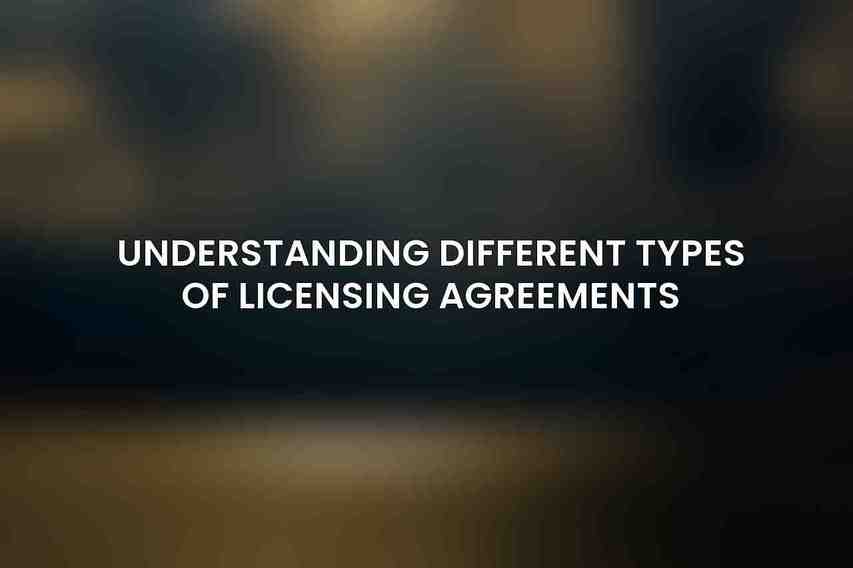enabling individuals and businesses to leverage their creations for various purposes. The primary purpose of licensing is to grant permission for the use of intellectual property while outlining the terms and conditions of such usage. There are several types of licensing agreements tailored to specific needs and circumstances.
Purpose of licensing
Licensing serves as a legal mechanism that allows the owner of intellectual property rights to authorize another party to use their creations in exchange for compensation. This can apply to a wide range of intellectual property, including patents, trademarks, copyrights, and trade secrets. By licensing their intellectual property, owners can generate revenue, expand their brand presence, and facilitate collaborations with other entities.
Types of licensing agreements
- Exclusive License: This type of license grants exclusive rights to use the licensed property to a single licensee. It means that no other party, including the licensor, can exploit the intellectual property during the agreement period.
- Non-Exclusive License: In contrast, a non-exclusive license allows multiple licensees to use the licensed property concurrently. This type of agreement provides flexibility for the licensor to grant the same rights to multiple parties.
Key Licensing Terms
A. Exclusivity
When delving into licensing agreements, understanding the concept of exclusivity is paramount.
1. Exclusive License
An exclusive license grants sole utilization rights to a licensee, prohibiting the licensor from granting the same rights to others. This can be advantageous for licensees seeking to monopolize a specific market segment.
Non-Exclusive License
In contrast, a non-exclusive license permits multiple licensees to utilize the licensed property concurrently. This allows for broader dissemination and use of the intellectual property.
B. Territory
Geographical considerations play a significant role in licensing agreements.
1. Geographic Territory
The geographic territory clause specifies the regions or countries where the licensee is authorized to use the intellectual property. This provision helps in delineating the scope of the agreement and avoiding conflicts over jurisdiction.
Field of Use
Apart from geographical boundaries, the field of use specifies the permitted applications of the licensed property. Whether it pertains to a specific industry, product category, or distribution channel, defining the field of use is crucial for preventing infringements. Dive deeper into Essential Legal Considerations in Digital Asset Licensing
C. Duration
The timeframe of a licensing agreement impacts the rights and obligations of both parties involved.
1. Term License
A term license grants the licensee the right to use the intellectual property for a predetermined period. This fixed-term arrangement provides clarity on the license’s duration and can be renewable based on mutual agreement.
Perpetual License
On the other hand, a perpetual license allows the licensee ongoing and indefinite use of the intellectual property. This type of license offers long-term security and stability in utilizing the licensed property.
D. Royalties
Royalties are a core component of licensing agreements, representing the financial compensation paid by the licensee to the licensor.
1. Types of Royalties
Royalties can take various forms, including flat fees, a percentage of sales, or a combination of both. The chosen structure often depends on the nature of the intellectual property and the agreed-upon terms between the parties.
Royalty Rates
Determining the royalty rates involves assessing multiple factors such as the exclusivity of the license, the designated territory, the duration of the agreement, and the anticipated usage of the intellectual property. Negotiating favorable royalty rates is critical for both parties’ financial interests.
E. Termination
Despite efforts to craft comprehensive licensing agreements, circumstances may arise that necessitate termination.
1. Grounds for Termination
Common grounds for terminating a licensing agreement include breaches of contract, non-payment of royalties, or other specified reasons agreed upon in the contract. Clear termination clauses help mitigate potential disputes and protect the interests of both parties.
Consequences of Termination
Upon termination, the licensee’s rights to use the licensed property cease, and any ongoing obligations or liabilities are typically addressed in the agreement. Understanding the repercussions of termination is vital for both parties to prepare for such scenarios effectively.
Understanding Different Types of Licensing Agreements

A. Trademark Licensing
Trademark licensing involves granting permission to use a trademark for promotional or commercial purposes. See our take on A Complete Guide to Understanding Digital Asset Licensing Basics
1. Purpose
The primary goal of trademark licensing is to enable third parties to leverage a brand’s identity for marketing products or services. This mutually beneficial arrangement can enhance brand visibility and generate additional revenue streams.
Considerations
When entering into trademark licensing agreements, factors such as the strength of the trademark, the duration of the license, and the geographic scope of authorized use must be carefully considered to safeguard the brand’s integrity. Discover our thoughts on Explore the Different Types of Digital Licenses Available Today
B. Copyright Licensing
Copyright licensing pertains to granting rights to reproduce, distribute, or adapt copyrighted works.
1. Purpose
Copyright licensing empowers creators to control how their works are utilized by others, ensuring proper attribution and compensation for their creative endeavors.
Considerations
Key considerations in copyright licensing agreements include the duration of copyright protection, the originality of the work being licensed, and the permissible uses granted to licensees. Learn more about Step-by-Step Guide on How to License Your Digital Assets
C. Patent Licensing
Patent licensing involves granting rights to manufacture, use, or sell patented inventions.
1. Purpose
The primary aim of patent licensing is to enable innovation diffusion by allowing others to benefit from patented technologies through licensing agreements.
Considerations
When engaging in patent licensing agreements, factors such as the expiration of the patent, the scope of the invention covered, and potential infringement risks need to be thoroughly evaluated to ensure a mutually beneficial and legally sound arrangement.
Negotiating Licensing Agreements

Navigating the negotiation process for licensing agreements requires meticulous preparation and strategic considerations.
A. Preparation
Before engaging in negotiations, it is essential to conduct thorough research on the licensed property, clarify your specific needs and objectives, and identify potential partners or licensees aligned with your business goals.
B. Negotiation Process
The negotiation process typically involves several stages, starting with drafting the initial agreement, exchanging proposals, and iteratively negotiating the terms until reaching a consensus. Finalizing and executing the agreement marks the formalization of the licensing partnership.
C. Drafting Considerations
In drafting licensing agreements, certain considerations are pivotal to ensure a clear and comprehensive understanding between the parties.
1. Clearly Define the Scope
Explicitly defining the scope of the license, including the rights granted, limitations, and permitted uses, is crucial for avoiding misunderstandings and potential conflicts down the line.
Protect Intellectual Property Rights
Safeguarding the intellectual property rights of both parties through confidentiality clauses, dispute resolution mechanisms, and indemnification provisions is essential for fostering trust and accountability in the licensing relationship.
Address Disputes and Termination
Anticipating potential disputes and termination scenarios by including dispute resolution protocols and termination clauses can help mitigate risks and streamline the resolution process if conflicts arise.
understanding the intricacies of licensing terms is indispensable for individuals and businesses seeking to maximize the value of their intellectual property assets. Obtaining legal advice when negotiating licensing agreements can provide invaluable guidance and ensure the terms are in alignment with legal requirements and best practices. By demystifying licensing terms and embracing the nuances of different types of licensing agreements, aspiring licensees and licensors can forge mutually beneficial partnerships that drive innovation and commercial success in the dynamic world of intellectual property.
Frequently Asked Questions
What are licensing terms?
Licensing terms refer to the conditions under which a licensee can use a licensed product or service. These terms outline the rights and obligations of both the licensor and the licensee.
Why are licensing terms important?
Licensing terms are crucial for protecting intellectual property rights and ensuring that both parties involved understand their roles and responsibilities. Clear licensing terms can help avoid misunderstandings and legal disputes.
What are common types of licensing agreements?
Common types of licensing agreements include exclusive licenses, non-exclusive licenses, sublicensing agreements, and royalty agreements. Each type of agreement has its own set of terms and conditions.
How can one negotiate favorable licensing terms?
To negotiate favorable licensing terms, it is important to thoroughly understand the terms of the agreement, conduct market research, identify key points of negotiation, and be willing to compromise. Seeking assistance from legal professionals can also be beneficial.
What are some key factors to consider when reviewing licensing terms?
When reviewing licensing terms, it is important to consider the scope of the license, exclusivity rights, royalties or fees, termination clauses, indemnification provisions, and any restrictions on use or distribution. It is essential to carefully review and understand all terms before signing any agreement.
